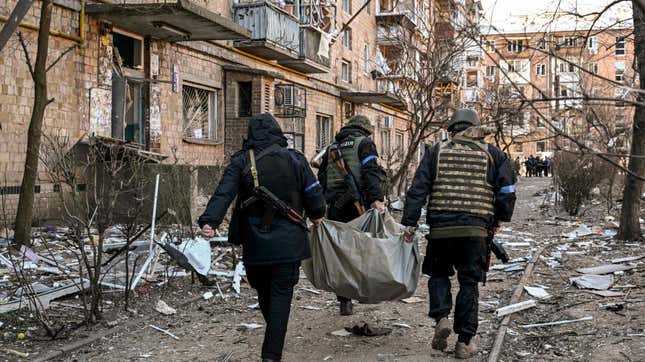
Notorious U.S. facial recognition technology from Clearview AI is now being used to identify deceased soldiers fallen on the battlefield.
In a recent interview with Reuters, Ukrainian Vice Prime Minister Mykhailo Fedorov said the military uses the tech to identify dead soldiers and then sends alerts to the fallen combatant’s family. As a reminder, Clearview’s facial recognition system works by comparing images of a subject against its database of billions of photos scraped from the public web, including social media networks. Specifically, Fedorov said the military uses the app to find a soldier’s social media account.
“As a courtesy to the mothers of those soldiers, we are disseminating this information over social media to at least let families know that they’ve lost their sons and to then enable them to come to collect their bodies,” Fedorov said. In a dark twist of modernity, the Ukrainian government has also created an online Google Form where Russian relatives can request to collect the remains of a dead soldier.
Fedorov took to Twitter late Wednesday, providing additional details of its identification process without specifically naming Clearview. “A month ago, we all worked on FaceID and CRM systems to process calls for eServices,” Fedorov wrote. “Now, we work on automatic identification of occupiers’ corpses and autodial RU subscribers to tell the truth about the war.”
In a statement sent to Gizmodo, Clearview CEO Hoan Ton-That said he believed facial recognition could reduce uncertainty in times of war.
“War zones can be dangerous when there is no way to tell apart enemy combatants from civilians,” Ton-That said. “Facial recognition technology can help reduce uncertainty and increase safety in these situations.” The CEO went on to say they are ensuring each person with access to its tool “is trained on how to use it safely and responsibly.” When we asked what that training entails, Ton-That didn’t elaborate but said it’s similar to training used outside of Ukraine.
The U.S. facial recognition firm reportedly began offering its technology to Ukraine, free of charge, earlier this month. At the time, Clearview executives suggested its technology could be used to screen travelers passing through security checkpoints and potentially even help reunite refugee families.
“What’s really fascinating is that it [facial recognition] could be a really big deterrent for potential infiltrators if they know that facial recognition is out there,” Ton-That said in an interview with NewsNation.
Though the specifics of Ukraine’s deceased soldier identification operation still remains mostly shrouded in mystery, the practice has already drawn scrutiny from some privacy expert like Surveillance Technology Oversight Project Executive Director Albert Fox Cahn who fears the possibility of misidentification.
“When facial recognition inevitably misidentifies the dead, it will mean heartbreak for the living,” Fox Cahn said in a recent interview with Forbes. Advocacy groups like Privacy International, meanwhile, have accused Clearview of exploiting the war for its own benefit.
“Whatever the intention, people in Ukraine are currently at their most vulnerable—offering to deploy controversial technologies that exploit personal data seems irresponsible and on the verge of exploiting people’s distress and despair,” Privacy International said in a statement. “As Clearview’s data collection has been found in violation of many countries’ privacy laws, this feels like trying to bandage a wound with an infected plaster.”
Recent reports from the Washington Post and elsewhere suggest Clearview has ambitions to expand its business beyond law enforcement. Internally, the company claims its data collection system uploads 1.5 billion images per month and could house a total of 100 billion images in its database by the end of 2022.